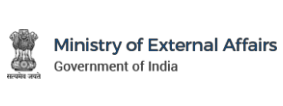It is indeed an honor and a privilege to be back at Harvard. I thank Ambassador Burns for inviting me here and for his words of welcome. I was here in Harvard in September 2010 when I was Foreign Secretary to deliver the Harish C. Mahindra memorial lecture.
Harvard has had a historical connection with India that goes back several decades. Sanskrit was taught at Harvard as early as in 1872. Even before that, in 1847, the Harvard Library had a copy of William Ward's A View of the History, Literature, and Mythology of the Hindoos, which was used by Ralph Emerson. There was a lively interest about India and things Indian among the Harvard student community. The University has been in the forefront among the US universities when it comes to the study of India and its society. Harvard is today not only continuing its tradition of engagement with India but has strengthened it through its South Asia Initiative and other programs, fostering mutual understanding between India and the United States, which is central to our partnership.
Before I come to the topic assigned to me, I would like to congratulate Harvard Professor and Nobel Laureate, India's Professor Amartya Sen, who has been awarded the 2011 National Humanities Medal by President Obama for his seminal work in the area of poverty, social justice, development economics and various facets of human development – all issues that impact lives of people.
Let me say that it is an honor for me to have yet another opportunity to address the Harvard community about the qualitative transformation taking place in India-US relations.
Towards common prosperity: People driven partnership
I am often asked the question - what is the central idea that is propelling the India-US partnership forward? While there are multiple factors that make this relationship so enduring - our shared values of democracy, respect for individual freedoms and diversity, rule of law, our converging interests on a number of regional and global issues, I believe the foremost among them are our excellent people-to-people connections that anchor our partnership and provide vitality and resilience to our relations.
And, it is this ‘people centric’ dimension of our partnership that I would like to focus on in my remarks today.
Links between our scientists, researchers, academics, entrepreneurs, art and culture enthusiasts, have always been an important component of such people to people ties. Indeed, a key element in the relationship between India and the United States has been that it responds to popular aspirations going beyond the calculations of political expediency. It is precisely for this reason that our relations enjoy such wide ranging support across the full political spectrum in both our countries.
You are well aware of the fact that US universities helped set up institutions of excellence such as the Indian Institute of Technology Kanpur and the Indian Institute of Management, Kolkata, institutions which are global brand names now. The United States was an early partner in helping to establish agricultural universities and research institutions in India in the 1960s. It was an American scientist, Nobel Laureate Norman Borlaug, who developed high yielding varieties of wheat in Mexico which were then adapted to Indian conditions in the institutions that US scientists helped establish. This was the beginning of the Green Revolution in India. Today, we work together to help realize an evergreen revolution to improve agricultural productivity in India.
The Fulbright program, established in 1950, has provided opportunities for more than 16,000 scholars both from India and the US to visit and pursue research and study in each other’s countries and has enhanced mutual understanding. This program was renewed in 2008 as the Nehru-Fulbright Program, and reflecting India’s increasing capabilities, was turned into a partnership with both India and the US becoming equal partners and contributing to substantially expand the program to provide more student and scholar exchange grants in priority fields such as science, technology and agriculture. About 300 students and scholars visit each country annually under this flagship program.
And, there is the US Peace Corps which sent its volunteers to India till 1976 and helped promote people to people linkages. More than 4,000 American volunteers spent time in India working mostly in rural communities. Last year, the Embassy had partnered with such volunteers to celebrate their 50th reunion. The over-whelming sentiment of the volunteers was how their stay in India had changed their lives and created lasting bonds of friendship with ordinary Indians, bonds which have endured and still thrive.
I visited, during the last five months I have been here, a number of academic institutions and universities in different parts of the U.S. And, wherever I go I find tremendous interest in establishing collaborative ventures with Indian institutions. There are Indian Study Centres/Initiatives at Universities such as Pennsylvania, Harvard, Yale, Michigan, Columbia, Duke and the list is continuously growing. The linkages with Indian institutions through the US Study Abroad program such as those run by Emory University, Lewis and Clark College, University of Iowa allow US students to explore contemporary India. The Singh-Obama 21st Century Knowledge Initiative announced in 2009 is strengthening teaching and research in both US and Indian institutions through university linkages and junior faculty development including greater emphasis on community colleges.
The US remains a preferred destination for Indian students to pursue their advanced degrees. Nearly 100,000 students from India are benefitting from the higher education system in the U.S. And we would like to see more and more American students coming to India in the future to study India. The newly launched ‘Passport to India’ initiative by the US State Department is a laudable initiative in this direction. And, I believe as the economic engagement between India and United States grows further, we would see continuous expansion in such exchanges between India and the United States, unleashing the creative energy of our youth for our common prosperity.
In October last year, we hosted the first ever India-US Higher Education Summit in Washington DC which has defined a strategic vision for the future of the US-India higher education partnership. As both our countries work towards becoming truly knowledge economies, I believe there are immense opportunities for forging newer links in the areas of education, research and innovation as also technology and skill development.
At the popular level, there is a tremendous interest and goodwill that Indian culture enjoys in the United States. This was evident when we hosted the ‘Maximum India’ festival last year in Washington DC. Our American friends were able to see and experience the rich tapestry of art and cultural heritage from different parts of India under one roof. To sustain this spirit of inquiry about India among our American friends, we hope to establish an Indian Cultural Center in Washington DC soon, which would provide a platform for exchange of ideas and intellectual discourse between our two peoples in the coming years.
Another critical area of our bilateral cooperation is in Science and Technology which is impacting the lives of our peoples in a significant manner. In recent years, our scientific cooperation has taken a new dimension to advance common goals in science, research and development, supporting partnerships between public and private research institutions and industry to meet pressing global problems such as environmental and biodiversity protection, safe drinking water, clean energy, climate change, finding cures for HIV/AIDS and other infectious and chronic diseases.
With the setting up of the bilateral Science and Technology Endowment Fund of US $ 30 million, we are capitalizing on our respective scientific and technological strengths to encourage promising and innovative ideas and creating an S&T eco-system, that could produce material benefits for both our peoples and support the vibrant entrepreneurial spirit in both countries. We have also, in yet another sign of mutual confidence, overcome concerns of the past on India’s space program and have made a promising beginning for a new era of cooperation.
And, the stellar role that the Indian-American Diaspora has been playing in deepening people-to-people linkages cannot be underestimated. They have created jobs and prosperity in this country and participated in the development of cutting edge and frontier technologies that have helped improve the lives of people. For instance, Indian American scientists have contributed to the Indian pharmaceutical sector including production of affordable Hepatitis Vaccine in India, and completing genome sequencing of Indian isolate of Hepatitis-C virus that causes chronic hepatitis. They are collaborating in establishing a Neutrino Observatory in India. Our scientists are now collaborating to enhance our ability to forecast the monsoon through the establishment of a ‘Monsoon Desk’ in NOAA which will ultimately help millions of farmers across India to improve their productivity and raise incomes.
Yet another central driver of our relations is our growing economic partnership. A number of US firms are capitalizing on the large pool of skilled engineers, scientists and researchers in India. A number of US companies have research centers in cities like Bangalore. Together they are producing innovative and affordable solutions in diverse fields such as health care and energy.
The steady growth of the Indian economy has not only helped improve the living standards of our people, but has also opened up new opportunities to expand our mutually beneficial economic and commercial ties with the United States. Two-way trade in goods and services continues to grow steadily reaching over US$ 100 billion last year. The US businesses are becoming strong partners in India’s economic growth story; and Indian businesses are creating value, wealth and jobs in the United States. Indian companies are now contributing strongly to local State economies in the US with a presence in 43 States and having invested over US$26 billion in the last 5 years in several key areas of the economy, in manufacturing as also in services. India's IT industry has in particular been a strong player in establishing value based mutually beneficial partnerships. As per our estimates, Indian IT companies employ over 100,000 people in the U.S. and the Indian IT industry supports over 280,000 jobs indirectly out of which about 200,000 are with U.S. residents.
In order to continue on the high growth trajectory, India will need to invest more than US $ 1 trillion in the coming years in building a world class infrastructure that could cater to the demands of a billion plus population and ensure the availability of clean sources of energy, including nuclear energy, to fuel such growth. In both these areas we are working with the US to build mutually beneficial ties. Because Indo-U.S. economic ties have been knowledge, technology and people-intensive, they have had a profound impact on the relationship that goes beyond the business sector.
A vital input to achieving the ambitious growth targets that we have set for ourselves would be energy. And increasingly it will have to come from clean sources. We are working together with the US across a full portfolio of clean energy options. The US is assisting us in mapping our reserves of shale gas resources.
The Civil Nuclear Initiative that has become a symbol of our transformed relationship and was welcomed by peoples from both sides and in which Ambassador Burns played such an important role, grew out of our conviction that nuclear energy could help us meet our energy requirements in an environmentally sustainable manner. There are immense opportunities for US companies in this sector and Indian and US companies are already engaged in a discussion to take cooperation forward in this crucial sector. On its part, the Government of India is committed to provide a level playing field for all our international partners.
Taken together, it is evident that people to people contacts remain at the heart of the India-US partnership. Backed by this extraordinary connectivity at the people level, both sides are expanding their strategic and political consultations on issues of mutual interest and responding to new geo-political and geo-strategic realities.
Towards common security and advancing global peace
As we work to enhance our mutual prosperity, there is also an increasing level of cooperation between our countries, to ensure peace and security both in the regional context and in the wider global context. All of us are familiar with the challenges that our two countries face - global economic stress, profound geopolitical changes especially in Asia, as also regional instability and the continuing threat of terrorism in South Asia. Whether it is terrorism or the challenge of maintaining peace amidst fast- paced changes in the Asia-Pacific, our interests increasingly converge; our understanding of the nature and the source of problems that we face has much in common.
Our cooperation in the field of security has broken new ground and explored new ideas and concepts. Our militaries, once unfamiliar with each other now hold regular dialogue and joint exercises in the air and on land and sea. We coordinate anti-piracy efforts and have worked together on humanitarian missions. Our defence trade was negligible a decade ago, but today we have placed orders worth US$ 8 billion on US defense equipment, and this is bound to grow even more in the future as India looks to modernize its armed forces. Our counterterrorism cooperation has acquired new momentum and depth, even as India continues to take steps to improve our domestic capabilities to counter this threat.
In Afghanistan, we are not only engaged in our individual assistance efforts but are now working together in areas such as capacity building, agriculture and women’s empowerment. Both our countries understand the imperative of ensuring success in Afghanistan. While successful transition of security in Afghanistan in 2014 is important, that alone would not guarantee long term stability in the region. This would require building of Afghan institutions, capacities and more importantly elimination of safe havens and infrastructure for terrorism and violent extremism in Afghanistan and Pakistan – a goal that both our countries share in common. India has invested significant resources for Afghanistan’s development in priority areas identified by Afghanistan. With its growing economy and expanding markets, India can and is willing to partner with other countries and play the role of an anchor for long term prosperity and stability of the region.
In the broader regional context of the on-going changes in Asia-Pacific region, there is today a much greater awareness between our two countries of our Asian-Pacific identities. The Asia-Pacific region is undergoing rapid changes and throwing up new challenges. India has always been conscious of her Asian identity, of our location at the strategic and cultural cross-roads of Asia. The future of the Asia Pacific region is of vital importance to India’s own future. The US too regards the region as one of special strategic focus.
The safety of the Sea Lanes of Communication in the Indian Ocean is vital for economic growth not just for India and the US but for the entire region. Maritime trade routes in the Indian Ocean are vital for international commerce and global energy security and we have a common interest in combating threats such as piracy. Therefore we have agreed to enhance our maritime security cooperation. For instance, we are working together with the US and the international community to combat piracy in the Gulf of Aden and off the coast of Somalia.
India and the U.S. have been described as natural strategic partners. Today, our strategic partnership has global significance. The expanding cooperation between India and the US remains firmly anchored in our shared values and our ability to work together in a variety of fields from fighting the menace of terrorism to ensuring the stability of the global economy. The India-US Strategic Dialogue initiated in 2009 has identified five principal areas for expanding cooperation: strategic cooperation, energy and climate change; education and development, economy, trade and agriculture, science and technology, health and innovation. The third meeting of the Dialogue will be held later this year.
Our leaders have laid out a strategic vision for one of the defining partnerships of the 21st Century. Our task is to advance this partnership, and impart it with further meaning and substance.
I see a future full of hope, promise and opportunities for deepening our strategic partnership guided by our long-term objectives and shared ideals of democratic functioning in order to meet the important challenges of our times and to advance peace and prosperity in our increasingly interdependent and interconnected world. And, in consolidating this important enterprise, the Indian and American people have a leading role.
With these words, I will be happy to take a few questions.
----







